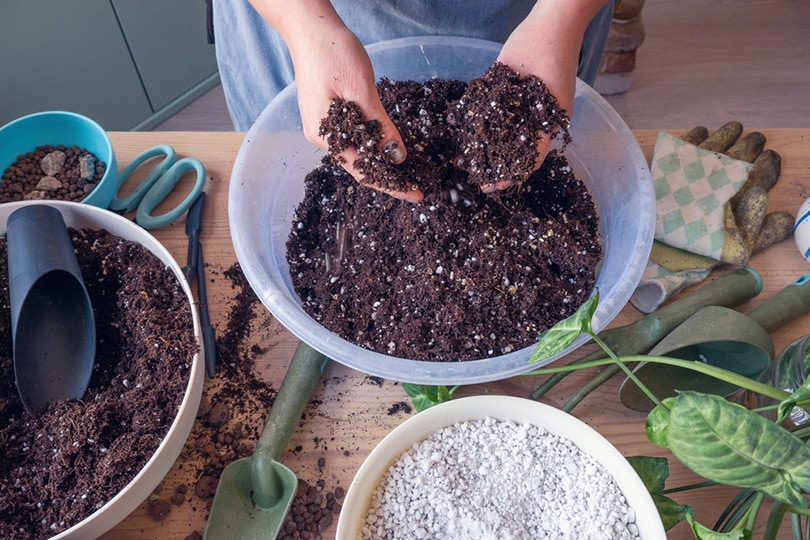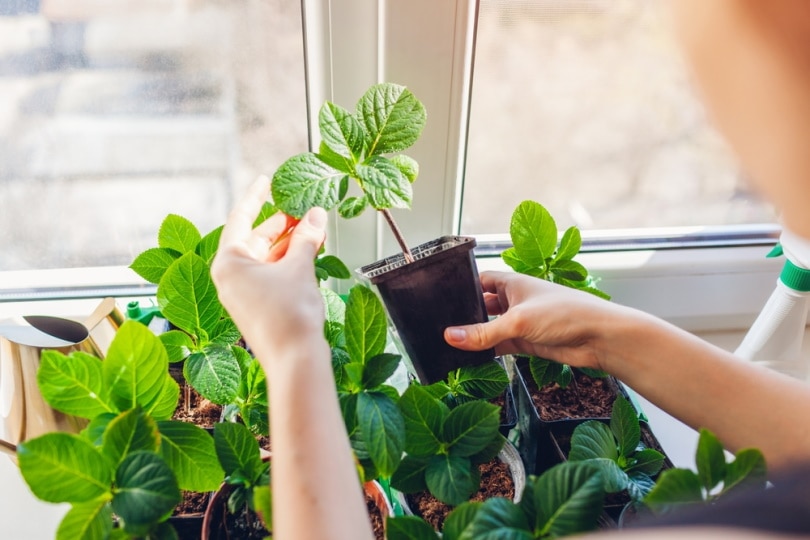Should I Add Vermiculite to My Soil? Facts & FAQ
-

- Last updated:

Vermiculite can improve the drainage and aeration in your soil, which can be beneficial for plants that prefer those conditions. It can also help hold moisture in the soil, which can be beneficial for plants that prefer moist conditions.
However, too much vermiculite can make the soil too dry or too wet, so it’s important to use it sparingly and only if your plants would benefit from the extra drainage or moisture retention. Read on to learn more about vermiculite and how to use it in your garden.
What Is Vermiculite?
Vermiculite is a natural mineral that is mined from the earth. It is light and fluffy and often used as an amendment to improve the drainage and aeration in potting mixes and soil. Vermiculite can also help hold moisture in the soil, making it a useful amendment for gardens in dry climates.

How Much Vermiculite Do I Mix With Soil?
The amount of vermiculite you should mix with your soil depends on the type of plant you are growing. For most plants, a 25% ratio of vermiculite to soil is a good starting point. If you are growing plants that require more drainage, you may want to increase the amount of vermiculite in your mix.
Conversely, if you are growing plants that prefer moist conditions, you may want to decrease the amount of vermiculite in your mix. Experiment and see what works best for your plants.
What Happens if You Add Too Much Vermiculite?
If you add too much vermiculite to your soil, it can cause the soil to become overly dry and compact. This can make it difficult for plants to root properly and may lead to stunted growth.
Additionally, vermiculite that is high in asbestos can be harmful if inhaled, so it’s important to use caution when handling it. If you’re unsure about how much vermiculite to add to your soil, it’s best to consult with a gardening expert.

How Do I Use Vermiculite?
Vermiculite is a soil amendment that can be used to improve the structure of heavy clay soils and provide aeration and drainage in sandy soils. It’s also useful as an ingredient in potting mixes. Vermiculite is available in several different particle sizes, from very fine to coarse. The coarser grades are better for use in gardens, while the finer grades are often used in potting mixes.
To use vermiculite in your garden, first determine what type of soil you have. If you have sandy soil, you’ll want to use a finer grade of vermiculite to help retain moisture. If you have clay soil, you’ll want to use a coarser grade of vermiculite to help improve drainage.
Once you’ve determined what type of soil you have, you can add between a 1/3-inch and ½-inch layer of vermiculite to your soil. For very sandy soils, you may need to add more vermiculite to help retain moisture. For clay soils, you may need to add less vermiculite to avoid making the soil too loose.
Vermiculite can also be used as an ingredient in potting mixes. When using vermiculite in potting mixes, it’s important to use a sterile grade of vermiculite to avoid introducing diseases into your plants. Vermiculite can also be used on its own as a potting medium, although it’s often mixed with other materials such as perlite or coco coir.
When adding vermiculite to your soil or potting mix, be sure to wear gloves and a dust mask to avoid inhaling the fine particles. Vermiculite can be dusty, and breathing in the dust can irritate your lungs.

Should I Add Vermiculite to My Potting Soil?
If you are growing plants in pots, adding vermiculite to the potting mix can be beneficial. However, you don’t want to add too much vermiculite, or the mix will become too light and dry. A good rule of thumb is to add no more than a third of vermiculite by volume.
Vermiculite is often used in conjunction with perlite, another type of mineral that is commonly added to potting mixes. Vermiculite holds more water than perlite, so it helps keep the mix moist. Perlite, on the other hand, is more porous and provides aeration. Both materials are lightweight and help improve drainage.
In general, vermiculite is a good amendment for potting mixes that tend to be heavy and dense, such as those containing a lot of peat moss. It can also be used to lighten up mixes that contain a lot of sand.
If you are using a commercial potting mix, you may not need to add any additional amendments. However, if you are making your own mix, adding vermiculite can help create a more balanced soil.

Do I Add Water to Vermiculite?
As long as you’re strictly using vermiculite, you may add water to it as needed. However, you want to make sure that you only add a very small amount, as too much water can make it difficult for roots to grow.
If you’re adding other ingredients to your vermiculite, such as perlite or soil, you’ll want to be careful not to add too much water overall. The best way to know how much water to add is to feel the mixture and make sure that it’s damp but not soggy.
Which Plants Like Vermiculite?
Vermiculite is a soil amendment that can be used to improve drainage and aeration in the root zone. It can also be used to help hold water and nutrients in the soil. Vermiculite can be beneficial for plants that prefer moist, well-drained soils. Some of the plants that like vermiculite include:
Be sure to check with your local nursery or garden center to see if vermiculite is right for the plants you have in mind.

In Conclusion
Vermiculite can provide you with many benefits, including improved drainage and aeration in your soil. It can also help to improve the overall structure of your soil. When used correctly, vermiculite can be a great addition to your gardening toolkit. Just be sure to use it in moderation and always follow the manufacturer’s guidelines for application.
You may also be interested in: Should You Add Sand to Clay Soil? Does It Help?
Featured Image Credit: VH-studio, Shutterstock
Contents

